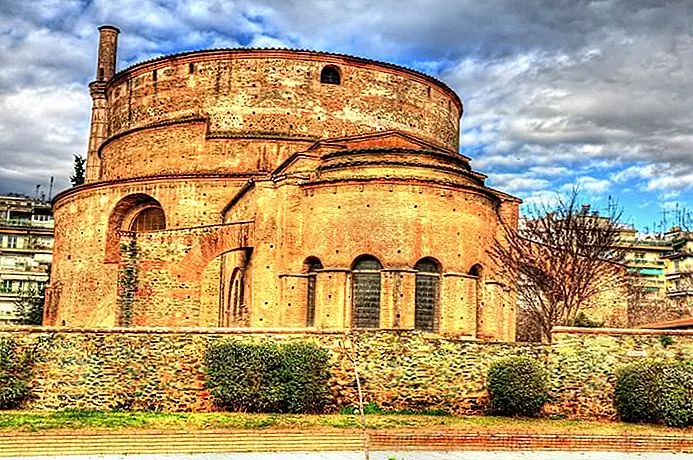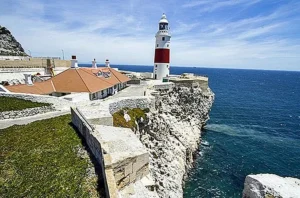Thessaloniki (also known as Salonica) offers the cosmopolitan culture and energy of a big city with the friendly atmosphere and charm of a smaller town. It is a wonderful destination to experience the real Greece without the crowds and congestion of Athens. This beautiful city has an impressive multi-ethnic heritage, influenced by the various civilizations that have left their mark, including the Romans, Venetians and Ottoman Turks. Visitors are awed by the ancient ruins, Byzantine churches and the world-class archaeological museum, one of the best in Greece. Another highlight is the delicious local cuisine; top restaurants tempt diners with the best culinary dishes from the region.
1 Roman Rotunda (St. George’s Church)
The Roman Rotunda is the most beautiful ancient monument in Thessaloniki. Built in the early fourth century, it was most likely intended as the mausoleum of Emperor Galerius (although he was not buried here) and was part of the complex containing the Galerius Palace and the Arch of Galerius. Emperor Theodosius the Great, who had been baptized as a Christian in Thessaloniki, converted the mausoleum into a Christian church in the late fourth century. During the 10th to 12th centuries, the Rotunda was used as the cathedral of Thessaloniki. Under Ottoman rule, the building was converted into a mosque; the minaret is a remnant from the Islamic era. After the liberation from the Turks in 1912, the Rotunda was transformed into the Church of Saint George (Áyios Yeóryios).
This grandiose sanctuary makes a breathtaking impression. The Rotunda has a diameter of more than 24 meters and a height of 30 meters and has a cylindrical architecture with a dome similar to the Pantheon in Rome. Inside, beautiful mosaics decorate the dome and vaulted recesses. The mosaic in the center of the dome is missing, but beneath it there are charming figures of angels and architectural facades on a golden background. The Rotonde houses a sculpture museum and is open to visitors every day.
Read also: Exploring Beit Shean: A Visitor’s Guide
2 The White Tower: Relic of the Byzantine-Era Ramparts

Thessaloniki’s most recognizable landmark, the White Tower, can be reached by taking a lovely walk along the seaside promenade. In a small public garden at the south end of the promenade, the White Tower (Lefkós Pyrgos) was once part of the city’s ancient ramparts. The circuit of fortress walls no longer remains completely intact; the White Tower is the only remnant of the seaward defenses. Built by the Ottoman Turks around 1530, this imposing tower was mainly used as a prison.
Today, tourists can visit the tower and ascend to the viewing platform at the top, which offers sensational views of the city and harbor. The White Tower also houses the permanent collection of the Museum of Byzantine Culture. The museum’s exhibitions educate visitors from around the 300th century to the conquest by the Turks in 1430 in Byzantine history and art in Thessaloniki. The collection includes a wide range of objects such as early Christian coins, vases, mosaics, murals and liturgical objects. The White Tower also hosts temporary exhibitions, such as presentations of Byzantine religious paintings.
3 Church of Saint Demetrius

A must-see spiritual sight in Thessaloniki, the Church of Saint Demetrius (Ayios Dimítrios) is the city’s main church. During the Turkish period it was converted into a mosque, the Kasimiye Cami. North of the Roman Agora, this beautiful five-aisled Byzantine basilica was built in the fifth century on the site of an earlier Christian church near the ancient Roman bathhouse. (Remains of the bathhouse are visible on the north side of the church.) The crypt also contains remains of an ancient Roman road.
The church is named after Demetrius, the city’s patron saint, who was imprisoned and executed here in the year 306. For centuries, pilgrims from the Byzantine Empire have come to venerate the saint’s relics, which are kept in a sarcophagus in front of the iconostasis . Spiritual pilgrims and tourists are awe-inspired upon entering the interior of the church. The glorious sanctuary is 43 meters long, the largest in Greece, and is richly decorated. Decorations include finely carved capitals on the varicolored marble columns, a dazzling chandelier in the central aisle and small mosaics on the pillars in the apse.
4 Arch of Galerius

From Egnatia Street towards the city center of Thessaloniki, visitors come across the Arch of Galerius (Apsída Galeríou), an ancient Roman monument dating back to around 297 AD. This arch was the main entrance to the old city. Of the original structure, three piers remain on the west side. Two of the surviving piers, connected by an arch, feature a marble facade decorated with detailed reliefs. The reliefs, separated by streamers, depict battle scenes from the Persian, Mesopotamian and Armenian campaigns of Emperor Galerius in the third and fourth centuries. These beautifully crafted reliefs are among the best of their kind. Note the animated scenes on the south pier. Although very weathered, the reliefs are much better preserved than contemporary reliefs on the Arch of Constantine in Rome,
5 Archaeological Museum

This renowned museum presents a wonderful collection of objects discovered in Thessaloniki and throughout ancient Macedonia. The collection ranges from prehistory to late antiquity. Be sure to see the sculptures from the Archaic to the Late Roman era. Several rooms display architectural elements from an Ionic temple from the sixth century BC. Other exhibits show excavation results from a Neolithic settlement at Makriyalo in Pieria, artifacts from the ancient palace built by Emperor Galerius and the reconstruction of a Macedonian tomb at Ayia Paraskevi. The archaeological museum also organizes temporary exhibitions on different themes, such as the coins of Macedonia. A display case in the museum lobby displays finds from a Neolithic site,
Address: 6 Manolis Andronikos Street, Hanth Square, Thessaloniki
Official site: www.amth.gr/index.php/en/
6 Ano Poli (Upper Town)

The Ano Poli is the historic old town, known as the Upper Town due to its hilltop location. The upper town can be reached from Odós Olympíados, the winding street that connects the lower town in the north with the old city walls and the citadel. This atmospheric neighborhood is characterized by its steep, winding streets and pedestrian alleys. Numerous Ottoman-era fountains reveal the quarter’s Turkish influence.
The Ano Poli has many notable historic churches including the Church of Saint Catherine, the Church of the Prophet Elijah, the Church of the Taxiarchs (Archangels), the Church of the Holy Apostles and the unmissable Church of Ósios Davíd which was built in the fifth and sixth century and is known for its beautiful mosaic depicting the vision of the prophet Ezekiel. Another famous site in this area is the Turkish Consulate at Odós Apóstolou Pávlou, the house where Mustafa Kemal Pasha (Atatürk), the first President of the Turkish Republic, was born in 1881.
7 Byzantine walls (old ramparts)

Shortly after Thessaloniki was founded in 315 BC, the city was surrounded by defensive walls to resist attacks by King Pyrrhus of Epirus in 285 and by the Celts in 279. Constantine the Great strengthened the fortifications and under the Byzantine Empire the walls were often improved. In the 14th and 15th centuries, Turkish authorities built additional defenses and towers, often using Venetian military engineers for construction. Until the 19th century, the old city was surrounded by a complete eight-kilometer circuit of walls. Unfortunately, the Ottoman government demolished the old walls to modernize and “beautify” the city. However, parts of the walls have recently been restored.
A good starting point for a tour of the Byzantine walls is at the Evangelistria Cemetery north of the university campus. From there, walk outside the walls to the massive 15th-century round tower known as the Trigonion (aka the Tower of Alysos). Beyond this is the tower of Anna Palaiologina, with an entrance gate leading to the Citadel, on the site of the ancient Acropolis. At the highest point is a fortress, the Heptapyrgion (“Seven Towers”), formerly used as a prison. From the Citadel, tourists can continue west along the walls, either inside or outside, to the Letaia Gate at the Church of the Holy Apostles and then to Democracy Square (Platía Dimokratías). From there the walls continue towards the harbour, ending at the Vardar Fort.
8 Church of the Holy Apostles

The Church of the Holy Apostles (Áyii Apóstoli) is located on the edge of the old town, close to the Byzantine walls. This beautiful 14th-century Byzantine church was designed on a cruciform ground plan, with five domes and detailed masonry masonry. A characteristic feature of late Byzantine architecture is the main dome rising above the barrel vault of the cross with the other domes over the corners of the portico. During the Turkish period the church was used as a mosque, the Soguk Su Camii (“Mosque of the Cold Spring”). The church has beautiful frescoes and mosaics from the Paleologue period, which were discovered during restoration work in 1940. On the north side of the church there is a cistern that belonged to the former Monastery of the Holy Apostles.
9 Church of Saint Sophia

Church of Saint Sophia
At the eastern end of Hermes Street (Odós Ermoú), the Church of Saint Sophia (Ayía Sofía) is one of the city’s most important historic churches. The domed church was built in the eighth century on a three-aisled cruciform plan. In the ninth and tenth centuries, after the iconoclastic conflict, the church was decorated with expressive figurative mosaics, including the mosaic of the Mother of God in the apse and a beautiful representation of the mosaic of the Ascension in the dome. Also striking are the capitals of the columns, probably from a fifth-century building. From 1204 to 1430, the Church of Saint Sophia was the metropolitan church (cathedral) of the city. During the Turkish period it was converted into a mosque, the Aya Sofya Camii.
10 Museum of the Macedonian Struggle
Housed in a neoclassical building from the 19th century, the museum educates visitors about the Macedonian struggle. The collection includes objects and photographs from 1900 to 1912. The most interesting exhibits are the weaponry, uniforms, memorabilia and personal effects of the leaders of the Macedonian struggle that took place from 1904 to 1908. The extensive photo collection contains 1,350 contemporary photographs. Also on display are explanatory maps, books, newspapers and paintings of the Macedonian landscape in the late 19th and early 20th centuries.
Address: 23 Proxenou Koromila Street, Thessaloniki
Official site: https://www.imma.edu.gr/imma/index.html
11 Villa Allatini
In the southwestern suburb of Kalamaria, visitors will discover many beautiful 19th-century villas and mansions. Many of these villas were designed by Italian architects in a neoclassical style. A house of particular historical interest is the Villa Allatini, created by Italian architect Vitaliano Poselli in 1896. Set in picturesque grounds, this stately villa was originally owned by a wealthy Jewish family, part of Thessaloniki’s thriving Jewish community. From 1926, the Villa Allatini served as a university building and it currently houses the offices of the Prefecture of Thessaloniki.
Address: 26 Vasileos Irakleiou, Thessaloniki
Where to Stay in Thessaloniki for Sightseeing
We recommend these great hotels in Thessaloniki, near top attractions such as the Roman Rotunda and the Arch of Galerius:
- The Excelsior: Luxury boutique hotel, central location, wonderful staff, serene decor, rooftop breakfast.
- Colors Urban Hotel: mid-range pricing, themed rooms, trendy decor, massages, themed garden.
- Anatolia Hotel: affordable prices, good value, modern decor, excellent free breakfast, spa with gym and sauna.
- Hotel Orestias Kastorias: budget hotel, convenient location, excellent customer service, free coffee and cookies.
Day trips from Thessaloniki
Archaeological Museum of Polygyros

The charming town of Polygyros, about 69 kilometers from Thessaloniki, is located in the foothills of the Halkidiki region. The town retains a traditional Greek character with its quaint little neighborhoods, which are a joy to explore. The main tourist attraction of Polygyros is the Archaeological Museum, an extensive collection of archaeological finds from the Halkidiki region. The collection spans the Bronze Age, the Archaic Age, the Classical Period and the Ancient Roman Age. Sculptures, reliefs, pottery, weapons and jewelry are on display. Highlights include the exhibits from the Archaic period, jewelry from the Late Archaic and Classical periods, and sculptures from the fourth century BC to the first century BC. Be sure to see the marble bust of Dionysos and the tomb statues of the Heroon at Stratoni. The range of objects discovered in the nearby town and cemetery of Olynthus are particularly interesting as they give an idea of daily life at the time.
Address: 1 Arhaiofouhou Moussiou Sreet, Polygyros
Mount Olympus

About 80 kilometers southwest of Thessaloniki, Mount Olympus is the highest mountain in Greece. It appears in Homer’s Iliad as the home of the gods, who were known as the Olympians. This mighty massif covers an area about 20 kilometers wide and climbs steeply to the summit, reaching its highest point in Mítikas at 2,917 meters. Although the highest ridges are difficult to climb, the northernmost peak (2787 meters) offers easier access. The best starting point for an ascent of Olympus is the town of Litóhoro in the eastern foothills of the mountain. From here, hikers can drive to Prionia, where there are trailheads for some of the most popular routes, including a gentle walk through the beautiful Enipeas Gorge. South of Mount Olympus flows the valley of Tempe,
Nature lovers can also visit Lake Vistonida, near the city of Porto Lagos, about a two-hour drive from Thessaloniki. This important wetland area attracts huge flocks of migratory birds and is excellent for bird watching with over 300 different species recorded here.
Read also:
Exploring Mount Tabor: A Guide for Visitors





